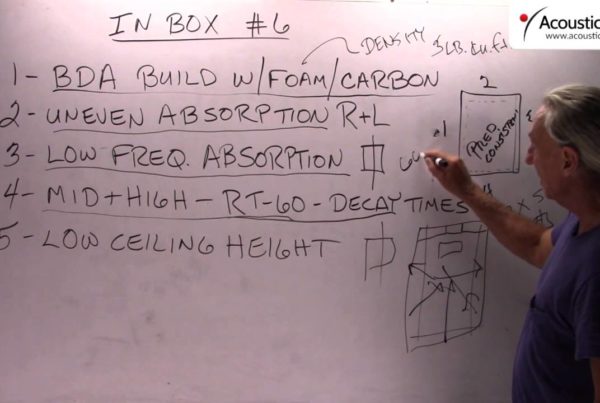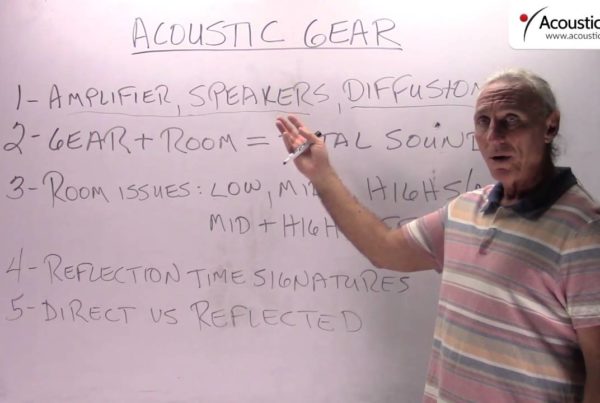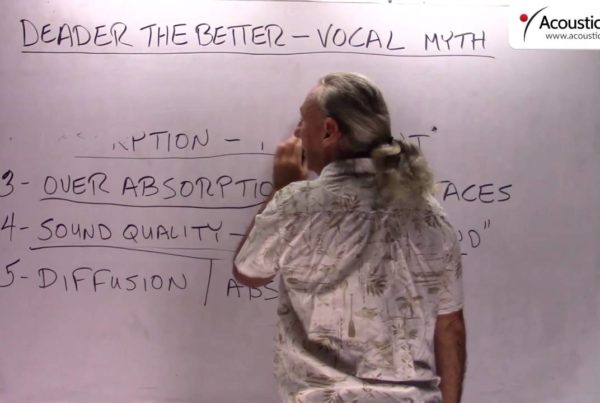Hi everyone, Dennis Foley from Acoustic Fields, today we’re going to talk about rate and level of absorption. I get a lot of calls from customers and they’re – most people are under the impression that all sound absorption materials are the same. Well, nothing could be further from the truth. Not only are they different, their rates and levels are different. But the sound quality that they impart upon your room is different. So you have to be very very careful. One size does not fit all. Definitely one size does not fit all when you’re talking about surface areas within a room.
So there’s a little definition here. Rate, it’s the rate of absorption. How much and what frequencies. That’s what you want to know. At 200 cycles how much energy is this particular material is absorbing, okay? It’s called absorption coefficient. Level. What is the top and the bottom range of the frequency response of the material you’re considering? What is the lowest frequency it absorbs at and how much? What is the highest frequency it absorbs at and how much? So you want to know the bottom and the top frequencies of absorption. You also want to look at the rate between those two.
So you have the bottom and you have the top. But you want to look at the rate of absorption. Does it get there quick? Does it do it smoothly? Is there a lot of peaks and troughs in the curve? You have to look at both things.
What rate and level, where in the room? It all depends on usage. A live room is going to be way different than a voice room, a vocal room. A control room is going to be different than a home theater or a listening room. So usage is very critical. You have to be careful where you put things. What rates and levels they absorb at and what the usage of the room is.
I see a lot of this Roxul 703 stuff out there. I don’t know how this got started, I just I can’t believe it’s so common in the literature. I know it’s cheap, I know it’s readily available but be very very careful about where you use this stuff. It does have applicability on the lower frequencies. But you’ve got to be careful with the middle and highs with it. It has a timber coloration that’s not good for mids and highs. We don’t use any of it in our builds. So be very very careful with it.
Where do you put what rate and level of absorption? Once again it depends on usage. Let’s take two channel listings because that’s a common one people are always concerned about. The side walls are different than the rear and the front walls. So you want some different rates and levels of absorption on both. Also depends on the dimensions of the room, the size of the speakers, what volume levels you play at, so all of this has to be taken into consideration.
We’re doing some testing now with different rates and levels of absorption on side walls and we’re finding that the front part of the room on the side wall is different than the rear and the middle is obviously the most critical because that’s the area that we’re involved with with out sound triangle. So you have to be very very careful about rates and levels. Definitely one size does not fit all. You can see in graphic five here. Here is a graphic of our foam compared to two of the other popular manufacturers. And those curves are those curves for a reason. And we’ll talk about that in another video.
Thank you,
Dennis Foley
—
This is an unedited transcript from our video series from Acoustic Fields. There will be some errors in grammar and sentence structure that occur during this translation process.
For complete understanding and comprehension, please view the video which is included in this text. For any additional information regarding this topic or others relating to room acoustics, please contact us directly at:
P: 520 – 392 – 9486









Use whatever floor type suits your usage. Carpet should have a carpet pad under the carpet. Hardwood floors should have…
Hello. This article mentions choosing a sound absorbing carpet and a pad. Could you please give examples of products? I…
All noise must be measured for frequency and amplitude. The barrier design chosen to fix the noise issue is dependent…
Hi, Really interesting article. I've just had a prototype water filtration and softening (using filters, not salt) system installed in…